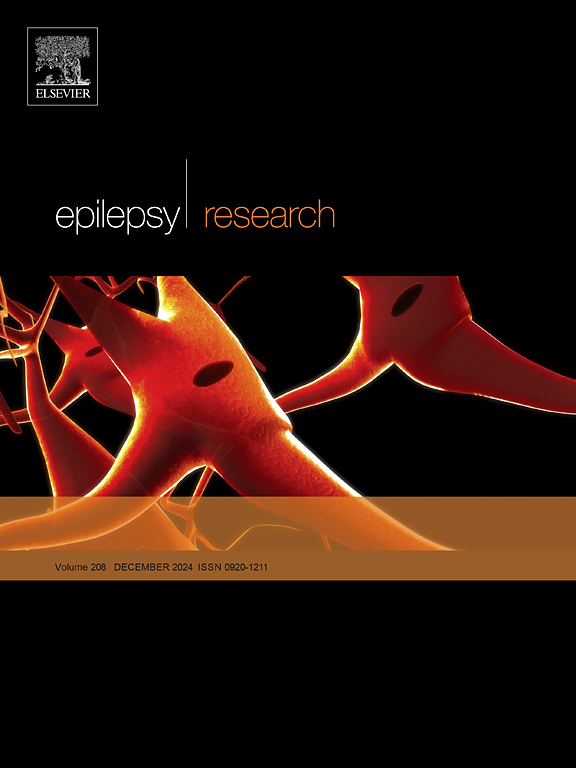Real world observational study investigating clinical effectiveness and safety of lacosamide in epilepsy: ULTIMATE study
IF 2
4区 医学
Q3 CLINICAL NEUROLOGY
引用次数: 0
Abstract
Objective
Primary generalized tonic-clonic seizures (pGTCS) are often misdiagnosed and remain challenging to manage due to limited treatment options. Lacosamide (LCM), approved for focal-onset seizures and adjunctive pGTCS therapy, was evaluated for real-world effectiveness in Indian patients.
Methods
This real-world, multicenter, retrospective, observational, and non-interventional study was conducted across 124 centers in India following approval from a centralized institutional ethics committee. Data were analysed using descriptive and analytical statistical methods for continuous and categorical variables, utilizing SPSS version 29.0.1.0.
Results
The Full Analysis Set (FAS) included 685 patients (245 females, 35.77 %; 440 males, 64.23 %) with a mean age of 43.30 ± 11.87 years. Among them, 301 (43.94 %) had pGTCS and 384 (56.06 %) had FoS. Concomitant ASMs for pGTCS included LEV (68.44 %), VPA (21.93 %), and CBZ (13.62 %), while for FoS, LEV (47.14 %) was most common, followed by VPA (16.15 %) and CBZ (14.58 %).
At week 12, mean seizure frequency in pGTCS reduced from 3 to 1 (p < 0.0001), with 52.16 % achieving seizure freedom and a 66.78 % responder rate. LCM with LEV showed a two-fold higher responder rate than with other ASMs (OR: 2.3582, p = 0.0037). In FoS, 47.66 % achieved seizure freedom, with a 58.85 % responder rate. Moreover, when prescribed as monotherapy in FoS, LCM showed a 62.96 % responder rate. LCM was generally well tolerated across both groups, with no unexpected safety concerns observed during the study period.
Conclusion
This study demonstrated the effectiveness of LCM therapy in reducing seizure frequency and improving seizure control in Indian patients with epilepsy. LCM was well tolerated and remains potential therapeutic option either as monotherapy or as an adjuvant therapy in the management of FoS.
真实世界观察性研究调查拉科沙胺治疗癫痫的临床有效性和安全性:终极研究
目的原发性全身性强直-阵挛性发作(pGTCS)经常被误诊,由于治疗方案有限,仍然具有挑战性。批准用于局灶性癫痫发作和辅助pGTCS治疗的拉科沙胺(LCM)在印度患者中的实际疗效进行了评估。方法这项真实世界的、多中心的、回顾性的、观察性的、非干预性的研究在印度124个中心进行,并获得了中央机构伦理委员会的批准。使用SPSS 29.0.1.0版本对连续变量和分类变量采用描述性统计和分析性统计方法进行数据分析。结果全分析集(FAS)纳入685例患者,其中女性245例,占35.77 %;男性440例,占64.23 %,平均年龄43.30 ± 11.87岁。其中pGTCS 301例(43.94 %),FoS 384例(56.06 %)。pGTCS伴发sm包括LEV(68.44 %)、VPA(21.93 %)和CBZ(13.62 %),FoS以LEV(47.14 %)最为常见,其次为VPA(16.15 %)和CBZ(14.58 %)。在第12周,pGTCS患者的平均癫痫发作频率从3次减少到1次(p <; 0.0001),52.16% %实现癫痫发作自由,66.78% %应答率。LCM合并LEV的有效率是其他asm的2倍(OR: 2.3582, p = 0.0037)。在FoS中,47.66 %实现了癫痫发作的自由,58.85 %的应答率。此外,当单药治疗FoS时,LCM的有效率为62.96 %。两组患者对LCM的耐受性普遍良好,在研究期间没有观察到意外的安全性问题。结论LCM治疗可有效降低印度癫痫患者的发作频率,改善癫痫控制。LCM耐受性良好,无论是作为单一疗法还是作为fo治疗的辅助疗法,LCM仍然是潜在的治疗选择。
本文章由计算机程序翻译,如有差异,请以英文原文为准。
求助全文
约1分钟内获得全文
求助全文
来源期刊

Epilepsy Research
医学-临床神经学
CiteScore
0.10
自引率
4.50%
发文量
143
审稿时长
62 days
期刊介绍:
Epilepsy Research provides for publication of high quality articles in both basic and clinical epilepsy research, with a special emphasis on translational research that ultimately relates to epilepsy as a human condition. The journal is intended to provide a forum for reporting the best and most rigorous epilepsy research from all disciplines ranging from biophysics and molecular biology to epidemiological and psychosocial research. As such the journal will publish original papers relevant to epilepsy from any scientific discipline and also studies of a multidisciplinary nature. Clinical and experimental research papers adopting fresh conceptual approaches to the study of epilepsy and its treatment are encouraged. The overriding criteria for publication are novelty, significant clinical or experimental relevance, and interest to a multidisciplinary audience in the broad arena of epilepsy. Review articles focused on any topic of epilepsy research will also be considered, but only if they present an exceptionally clear synthesis of current knowledge and future directions of a research area, based on a critical assessment of the available data or on hypotheses that are likely to stimulate more critical thinking and further advances in an area of epilepsy research.
 求助内容:
求助内容: 应助结果提醒方式:
应助结果提醒方式:


